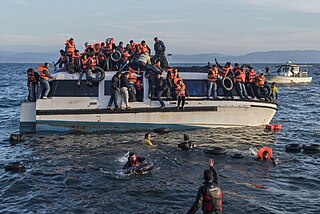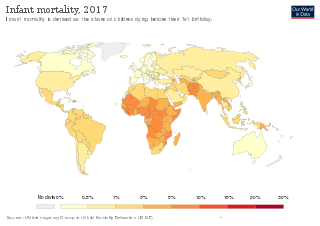 W
WIn biology, a population is a number of all the organisms of the same group or species who live in a particular geographical area and are capable of interbreeding. The area of a sexual population is the area where inter-breeding is possible between any pair within the area and more probable than cross-breeding with individuals from other areas.
 W
WBacterial growth is proliferation of bacterium into two daughter cells, in a process called binary fission. Providing no event occurs, the resulting daughter cells are genetically identical to the original cell. Hence, bacterial growth occurs. Both daughter cells from the division do not necessarily survive. However, if the number surviving exceeds unity on average, the bacterial population undergoes exponential growth. The measurement of an exponential bacterial growth curve in batch culture was traditionally a part of the training of all microbiologists; the basic means requires bacterial enumeration by direct and individual, direct and bulk (biomass), indirect and individual, or indirect and bulk methods. Models reconcile theory with the measurements.
 W
WA census is the procedure of systematically enumerating, and acquiring and recording information about the members of a given population. This term is used mostly in connection with national population and housing censuses; other common censuses include agricultural, traditional culture, business, supplies, and traffic censuses. The United Nations defines the essential features of population and housing censuses as "individual enumeration, universality within a defined territory, simultaneity and defined periodicity", and recommends that population censuses be taken at least every ten years. United Nations recommendations also cover census topics to be collected, official definitions, classifications and other useful information to co-ordinate international practices.
 W
WChitungwiza – known colloquially as Chi Town – is a high-density dormitory town in Zimbabwe. It is approximately 30 kilometres (19 mi) south-east of the Harare city centre. It was formed in 1978 from three townships: Seke, Zengeza, and St Marys.From early 2000s another township named Manyame Park was established making them four then in the mid 2000s another township named Rockview was also formed to make it 5 main townships.
 W
WThe Commission on Population and Development (CPD) is one of the ten Functional Commissions of the United Nations Economic and Social Council. At its establishment by ECOSOC in October 1946, the Commission's name was "Population Commission" and in December 1994, was changed to "Commission on Population and Development".
 W
WDemographic history is the reconstructed record of human population in the past. Given the lack of population records prior to the 1950s, there are many gaps in our record of demographic history. Historical demographers must make do with estimates. models and extrapolations. For the methodology, see Historical demography
 W
WPopulation ecology is a sub-field of ecology that deals with the dynamics of species populations and how these populations interact with the environment, such as birth and death rates, and by immigration and emigration).
 W
WEmigration is the act of leaving a resident country or place of residence with the intent to settle elsewhere. Conversely, immigration describes the movement of people into one country from another. Hence one might emigrate from one's native country to immigrate to another country. Both are acts of migration across national or other geographical boundaries.
 W
WA famine is a widespread scarcity of food, caused by several factors including war, inflation, crop failure, population imbalance, or government policies. This phenomenon is usually accompanied or followed by regional malnutrition, starvation, epidemic, and increased mortality. Every inhabited continent in the world has experienced a period of famine throughout history. In the 19th and 20th century, it was generally Southeast and South Asia, as well as Eastern and Central Europe that suffered the most deaths from famine. The numbers dying from famine began to fall sharply from the 2000s.
 W
WFamine 1975! America's Decision: Who Will Survive? is a best-selling 1967 book by William and Paul Paddock. The brothers describe the rapidly growing population of the world, and a situation in which they believe it would be impossible to feed the entire global population within the short-term future. They believed that widespread famine would be the inevitable result, by 1975.
 W
WForced displacement is the involuntary or coerced movement of a person or people away from their home or home region. This movement may have been caused by a variety of factors including natural disasters, violence, ethnic cleansing, individual or group persecution, droughts, civil wars, deportation and population transfer. The UNHCR defines 'forced displacement' more narrowly as: displaced "as a result of persecution, conflict, generalized violence or human rights violations".
 W
WThe Gompertz–Makeham law states that the human death rate is the sum of an age-dependent component, which increases exponentially with age and an age-independent component. In a protected environment where external causes of death are rare, the age-independent mortality component is often negligible. In this case the formula simplifies to a Gompertz law of mortality. In 1825, Benjamin Gompertz proposed an exponential increase in death rates with age.
 W
WA growth curve is an empirical model of the evolution of a quantity over time. Growth curves are widely used in biology for quantities such as population size or biomass, individual body height or biomass. Values for the measured property can be plotted on a graph as a function of time; see Figure 1 for an example.
 W
WWhen a quantity grows towards a singularity under a finite variation it is said to undergo hyperbolic growth. More precisely, the reciprocal function has a hyperbola as a graph, and has a singularity at 0, meaning that the limit as is infinite: any similar graph is said to exhibit hyperbolic growth.
 W
WImmigration is the international movement of people to a destination country of which they are not natives or where they do not possess citizenship in order to settle as permanent residents or naturalized citizens.
 W
WInfant mortality is the death of young children under the age of 1. This death toll is measured by the infant mortality rate (IMR), which is the probability of deaths of children under one year of age per 1000 live births. The under-five mortality rate, which is referred to as the child mortality rate, is also an important statistic, considering the infant mortality rate focuses only on children under one year of age.
 W
WIn animals, infanticide involves the killing of young offspring by a mature animal of the same species, and is studied in zoology, specifically in the field of ethology. Ovicide is the analogous destruction of eggs. The practice has been observed in many species throughout the animal kingdom, especially primates but including microscopic rotifers, insects, fish, amphibians, birds and mammals. Infanticide can be practiced by both males and females.
 W
WJelovik is a village in the municipality of Aranđelovac, Serbia.
 W
WLife expectancy is a statistical measure of the average time an organism is expected to live, based on the year of its birth, its current age, and other demographic factors including gender. The most commonly used measure is life expectancy at birth (LEB), which can be defined in two ways. Cohort LEB is the mean length of life of an actual birth cohort and can be computed only for cohorts born many decades ago, so that all their members have died. Period LEB is the mean length of life of a hypothetical cohort assumed to be exposed, from birth through death, to the mortality rates observed at a given year.
 W
WIn actuarial science and demography, a life table is a table which shows, for each age, what the probability is that a person of that age will die before their next birthday. In other words, it represents the survivorship of people from a certain population. They can also be explained as a long-term mathematical way to measure a population's longevity. Tables have been created by demographers including Graunt, Reed and Merrell, Keyfitz, and Greville.
 W
WA logistic function or logistic curve is a common S-shaped curve with equation
 W
WThe word "longevity" is sometimes used as a synonym for "life expectancy" in demography. However, the term longevity is sometimes meant to refer only to especially long-lived members of a population, whereas life expectancy is always defined statistically as the average number of years remaining at a given age. For example, a population's life expectancy at birth is the same as the average age at death for all people born in the same year. Longevity is best thought of as a term for general audiences meaning 'typical length of life' and specific statistical definitions should be clarified when necessary.
 W
WA megacity is a very large city, typically with a population of more than 10 million people. Precise definitions vary: the United Nations Department of Economic and Social Affairs in its 2018 "World Urbanization Prospects" report counted urban agglomerations having over 10 million inhabitants. A University of Bonn report held that they are "usually defined as metropolitan areas with a total population of 10 million or more people". Others list cities satisfying criteria of either 5 or 8 million and also have a population density of 2,000 per square kilometre. The terms conurbation, metropolis, and metroplex are also applied to the latter.
 W
WA metapopulation consists of a group of spatially separated populations of the same species which interact at some level. The term metapopulation was coined by Richard Levins in 1969 to describe a model of population dynamics of insect pests in agricultural fields, but the idea has been most broadly applied to species in naturally or artificially fragmented habitats. In Levins' own words, it consists of "a population of populations".
 W
WThe net migration rate is the difference between the number of immigrants and the number of emigrants throughout the year. When the number of immigrants is larger than the number of emigrants, a positive net migration rate occurs. A positive net migration rate indicates that there are more people entering than leaving an area. When more emigrate from a country, the result is a negative net migration rate, meaning that more people are leaving than entering the area. When there is an equal number of immigrants and emigrants, the net migration rate is balanced.
 W
WMortality rate, or death rate, is a measure of the number of deaths in a particular population, scaled to the size of that population, per unit of time. Mortality rate is typically expressed in units of deaths per 1,000 individuals per year; thus, a mortality rate of 9.5 in a population of 1,000 would mean 9.5 deaths per year in that entire population, or 0.95% out of the total. It is distinct from "morbidity", which is either the prevalence or incidence of a disease, and also from the incidence rate.
 W
WThe Office of Population Research (OPR) at Princeton University is the oldest population research center in the United States. Founded in 1936, the OPR is a leading demographic research and training center. Recent research activity has primarily focused on healthcare, social demography, urbanization, and migration. The OPR's research has been cited in numerous articles by the New York Times and the Wall Street Journal.
 W
WThe optimum population is a concept where the human population is able to balance maintaining a maximum population size with optimal standards of living for all people.
 W
WPopulation Geography relates spatial variations in the distribution, composition, migration, and growth of populations to the terrain. Population geography involves demography in a geographical perspective. It focuses on the characteristics of population distributions that change in a spatial context. This often involves factors such as where populations are found and how the size and composition of these populations is regulated by the demographic processes of fertility, mortality, and migration. Contributions to population geography are cross-disciplinary because geographical epistemologies related to environment, place and space have been developed at various times. Related disciplines include geography, demography, sociology, and economics. Since its inception, population geography has taken at least three distinct but related forms, the most recent of which appears increasingly integrated with human geography in general. The earliest and most enduring form of population geography emerged in the 1950s, as part of spatial science. Pioneered by Glenn Trewartha, Wilbur Zelinsky, William A. V. Clark, and others in the United States, as well as Jacqueline Beujeau-Garnier and Pierre George in France, it focused on the systematic study of the distribution of population as a whole and the spatial variation in population characteristics such as fertility and mortality. Population geography defined itself as the systematic study of:the simple description of the location of population numbers and characteristics the explanation of the spatial configuration of these numbers and characteristics the geographic analysis of population phenomena.
 W
WA population pyramid, also called an "age-gender-pyramid", is a graphical illustration that shows the distribution of various age groups in a population, which forms the shape of a pyramid when the population is growing. Males are conventionally shown on the left and females on the right, and they may be measured by raw number or as a percentage of the total population. This tool can be used to visualize the age of a particular population. It is also used in ecology to determine the overall age distribution of a population; an indication of the reproductive capabilities and likelihood of the continuation of a species.
 W
WPopulation transfer or resettlement is the movement of a large group of people from one region to another, often a form of forced migration imposed by state policy or international authority and most frequently on the basis of ethnicity or religion but also due to economic development. Banishment or exile is a similar process, but is forcibly applied to individuals and groups.
 W
WWithin the framework of the World Health Organization's (WHO) definition of health as a state of complete physical, mental and social well-being, and not merely the absence of disease or infirmity, reproductive health, or sexual health/hygiene, addresses the reproductive processes, functions and system at all stages of life. UN agencies claim sexual and reproductive health includes physical, as well as psychological well-being vis-a-vis sexuality.
 W
WThe sex ratio is the ratio of males to females in a population. In most sexually reproducing species, the ratio tends to be 1:1. This tendency is explained by Fisher's principle. For various reasons, however, many species deviate from anything like an even sex ratio, either periodically or permanently. Examples include parthenogenic species, periodically mating organisms such as aphids, some eusocial wasps such as Polistes fuscatus and Polistes exclamans, bees, ants, and termites.
 W
WSub-replacement fertility is a total fertility rate (TFR) that leads to each new generation being less populous than the older, previous one in a given area. The United Nations Population Division defines sub-replacement fertility as any rate below approximately 2.1 children born per woman of childbearing age, but the threshold can be as high as 3.4 in some developing countries because of higher mortality rates. Taken globally, the total fertility rate at replacement was 2.33 children per woman in 2003. This can be "translated" as 2 children per woman to replace the parents, plus a "third of a child" to make up for the higher probability of boys born and mortality prior to the end of a person's fertile life. In 2020, the average global fertility rate is around 2.4 children born per woman.
 W
WThe United Nations Department of Economic and Social Affairs is part of the United Nations Secretariat and is responsible for the follow-up to major United Nations Summits and Conferences, as well as services to the United Nations Economic and Social Council and the Second and Third Committees of the United Nations General Assembly. UN DESA assists countries around the world in agenda-setting and decision-making with the goal of meeting their economic, social and environmental challenges. It supports international cooperation to promote sustainable development for all, having as a foundation the 2030 Agenda for Sustainable Development and the 17 Sustainable Development Goals (SDGs) as adopted by the UN General Assembly on 25 September 2015. In providing a broad range of analytical products, policy advice, and technical assistance, UN DESA effectively translates global commitments in the economic, social and environmental spheres into national policies and actions and continues to play a key role in monitoring progress towards internationally agreed-upon development goals. It is also a member of the United Nations Development Group.